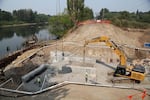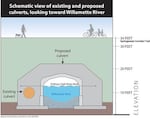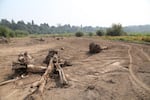
Construction crews install a new culvert that will make it easier for fish to travel between the Willamette River and the Oaks Bottom Wildlife Refuge. The 16-foot culvert will replace an old one that was only 5 feet in diameter.
Joseph Winters, OPB / EarthFix
The Oaks Bottom Wildlife Refuge is the largest undeveloped stretch of the Willamette River floodplain below Willamette Falls. It's 175 acres of prime habitat.
But for nearly a century, a small culvert has blocked young salmon from swimming into this sanctuary in the heart of Southeast Portland.
This week, the city of Portland and the U.S. Army Corps of Engineers started construction on a project that's designed to let the salmon back in.
The project will replace an old culvert that’s 5 feet in diameter with a new one that’s 16 feet wide and 10 feet tall. It’s also restoring the habitat leading into the Oaks Bottom Wildlife Refuge by deepening the side channels and adding large wood and native plants.

A new culvert will allow juvenile salmon in the Willamette River to swim under the Springwater Corridor Trail and into the Oaks Bottom Wildlife Refuge in Southeast Portland.
Courtesy of the City of Portland and U.S. Army Corps of Engineers
Young salmon swimming down the Willamette River need places to stop to eat and to hide from predators on their way to the ocean, said Ronda Fast, environmental coordinator with Portland’s Bureau of Environmental Services.
But once they pass Willamette Falls in Oregon City, most of the places that would provide these "rest stops" have been wiped out by development.
“Oaks Bottom is such an important wildlife refuge that salmon can’t currently get to,” Fast said. “There’s not a lot of habitat left within this stretch of the river between Willamette Falls and the confluence with the Columbia where salmon can find food and shelter on their journey.”

A restoration project is excavating side channels to connect the Willamette River with a lagoon in the Oaks Bottom Wildlife Refuge. Large pieces of wood have been placed in the channels to provide shady hiding places for salmon and other fish.
Joseph Winters, OPB / EarthFix
Fast said the Oaks Bottom restoration project is designed to welcome young salmon into the cool, slow-moving waters of the wildlife refuge, where there will be lots of food for them to eat.
“We are removing barriers for salmon so they can access prime habitat,” she said.
Jim Adams, project manager for the U.S. Army Corps of Engineers said juvenile salmon need side-channel areas like the Oaks Bottom Wildlife Refuge, but don’t have any for a long stretch of the Willamette River through the Portland metro area.
“This is the last existing off-channel wetland area between Willamette Falls and the Columbia River,” he said. “There is a huge gap that allows for a lot of predation. A significant amount of fish get eaten before they get there.”
Adams said the Oaks Bottom area is rare “low-hanging fruit” that can be easily restored to help salmon survive. The city and the Corps also have plans to replace another culvert blocking salmon habitat on Tryon Creek in Southwest Portland.
“It gets harder and harder to find areas that haven’t been developed that can be easily restored to their near original condition,” he said.
After the new culvert is installed at Oaks Bottom, the berm, the trail and railroad on top will be replaced. The project has closed a section of the Springwater Corridor Trail through October.
The salmon habitat project would bring back more finned wildlife to Oaks Bottom. But they'll have lots of company. Check out the Portland Bureau of Environmental Services' "critter cam" footage of otters helping themselves to a fish that made its way into the wetland:
